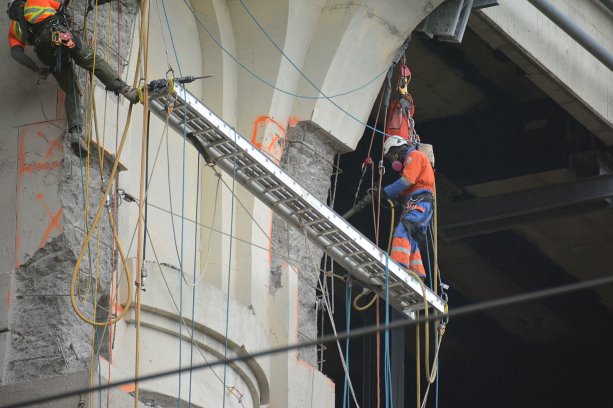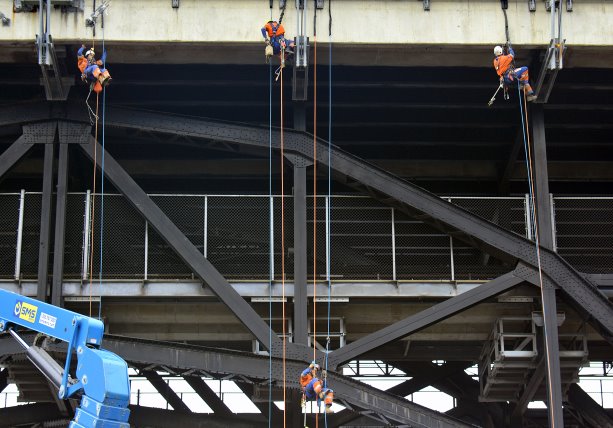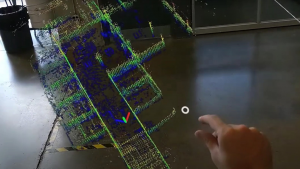A subcontractor on the Prince Edward Viaduct structural rehabilitation project in Toronto, Ont. is using an innovative technique called rope access, which is the first time this method has been applied in the local market.
"The most unique part of this project is the access under the bridge," said Masih (Moose) Moosazadeh, rope access manager with Rope Access Maintenance (RAM). "I have never seen another contractor company do the access before the way we did it in Toronto. And, it has opened up a lot of doors and awareness in terms of what is possible and what is safe."
Toronto Zenith Contracting Limited has hired RAM to use innovative access techniques on a $22-million contract for the rehabilitation of the Prince Edward Viaduct, commonly known as the Bloor Viaduct.
One of the major challenges on the project is gaining access to the bridge in general, because the structure is 135 feet high and the piers are difficult to access.
"On this project a large company like Toronto Zenith has allowed us to demonstrate that the technology actually does work," said Moosazadeh. "We know it works, because we have seen it done in Europe and we have done the work out east and out west. We are educating the local market on what the possibilities are and showing it can be scaled and applied to heavy civil construction."
According to Moosazadeh, rope access is a new technology in Ontario. RAM was subcontracted by Toronto Zenith to remove some old Bell utilities and upgrade the drainage system.
"There is obsolete Bell conduit that runs the entire length of the bridge, but there was no information on how it was installed or what was keeping it in place," said Moosazadeh. "The main challenge being that the bridge and the train underneath it are so rough and random it is difficult to get manlifts, lifts and conventional equipment in there to do the work."
Another barrier to access was the suicide barrier, which consists of more than 9,000 steel rods, 12.7 centimetres apart and five metres high, stretched to cantilevered girders.
In response to this challenge, a member of the RAM work crew went up to the deck of the bridge to secure and drop ropes down.
Then the crews would climb up the ropes from underneath the Bell conduit, raise a platform, and erect their own rope access self-protection system.
The crew could walk on the platform, which was easily manageable for one person, but is commercially rated for two people to work on. They removed the Bell conduit in 20 foot sections starting in August 2014.
The conduit removal was the first portion of RAM’s work on the project. The Toronto Transit Commission (TTC) shut down the train to complete this work in December 2014.
The next piece of work RAM is undertaking on the project are the drains. There are more than 40 vertical drains on the Bloor Viaduct, which keep water away from the steel structure to stop corrosion.
Once again, access is a challenge because the drains sit directly under the soffit of the decks, above the TTC trains and below the suicide barrier.
"We climbed up the rope, took our measurements, cut off the old piece and fabricated a new piece on the bottom," said Moosazadeh. "The fibreglass pieces with the elbows and flanges were then raised up. It was so light weight that the technician would just stay in place there using the ropes."
The crew clipped themselves on to the structural steel under the bridge, which allowed them to crawl around under the bridge to work on the drains.
RAM helped with a small amount of the concrete restoration by chipping and sanding concrete on one of the piers, which could not be reached by a manlift.
Moosazadeh said RAM picked up some extra work installing swing stage anchors under the bridge for Toronto Zenith workers.
The scope of work for Toronto Zenith on the project includes concrete rehabilitation work to the existing piers, as well as new reinforcing steel, structural steel repairs and coating of steel.
RAM is a St. John, New Brunswick-based company with offices in Richmond BC, Calgary, Fort Saskatchewan, Toronto, Corner Book, N.L, Las Vegas, Nevada and four locations in Mexico.
Follow Richard Gilbert on Twitter @buildingcanada.












Recent Comments
comments for this post are closed